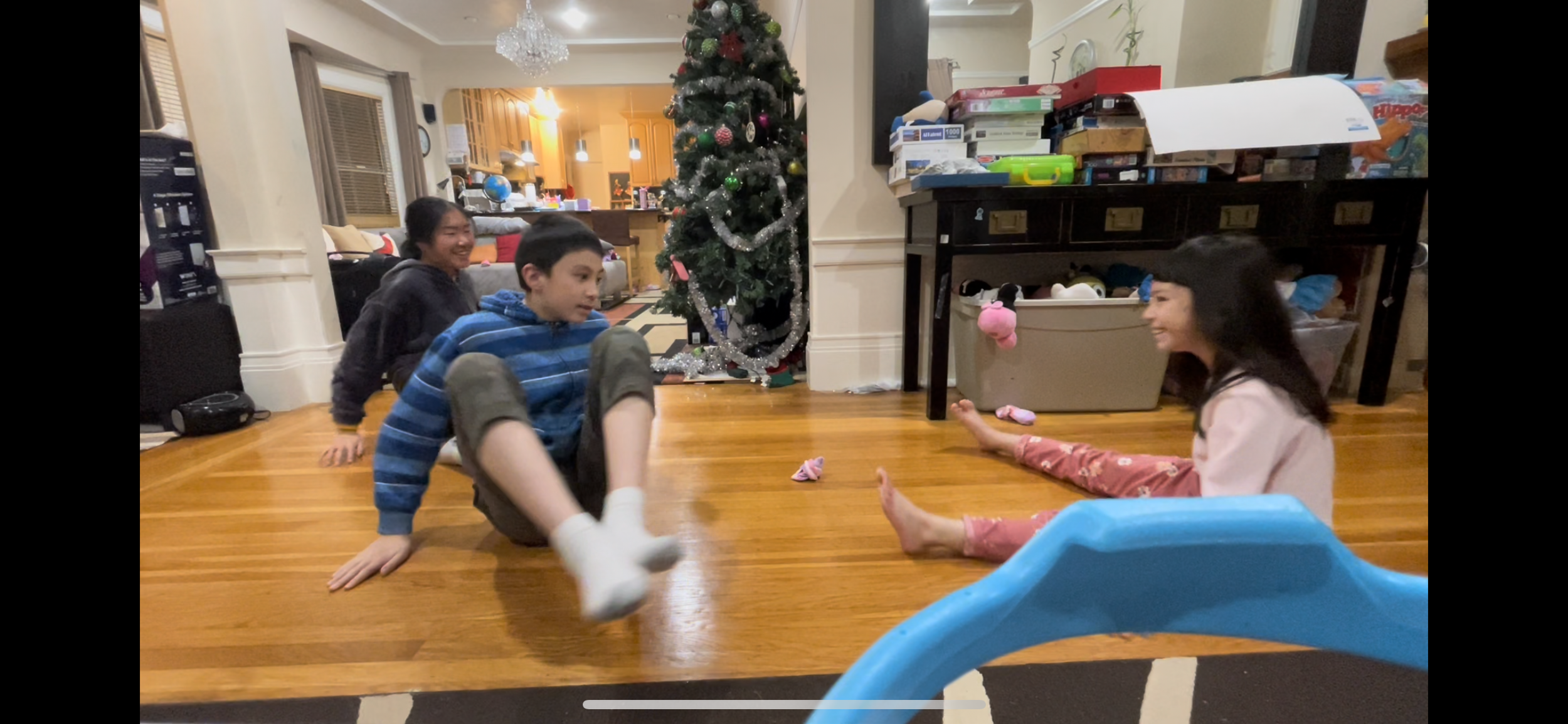3B: Written Overview:
1. Describe your process. Why did you choose your project? Why did you choose this method for sharing it?
I chose this project because I wanted to combine my love for movement and kids. I’m saddened that as kids grow up, they slowly lost that sense of playfulness and curiosity which is so so precious. My younger cousin(8yo girl) attends gymnastics classes, and the older cousin(12yo boy) is on the school’s basketball team and is into strength-building things these days(“toxic linearity in fitness culture” oh yay). Though the sports themselves have the space for play, little encouragement for improvisation/feel-good movements is offered by the teachers. I wonder if floor work classes could be the anchor that helps kids keep their curiosity and playfulness as they grow up. So I wanted to bring floor work to my two kids at home and see their reactions.
I chose this method for sharing because it just seems the most straightforward to see the kids’ reactions.
(p.s. the last minute is both of them on the spin pole lol, I’m nurturing the next generation of polers, so you are welcome)
2.. What felt good (or provided a healthy challenge) in creating this project?
The initial challenge was how to get the kids interested. Like how do I explain “floor work” and a “loop” in a way that they can understand and also finds fun? Kids don’t understand fancy jargon like, "using floor work to deepen mind-body-soul connection,” so I had to think about ways to make them excited. When I was getting ideas from Marlo’s YT channel, the first video was to introduce more swirls into floor work. I thought that would be perfect to teach the kids because who doesn’t like to spin on the floor?! So I just asked them if they wanna learn some cool tricks which will help them spin and swirl on the floor, and they said yes!
Then the challenge was also the space. The only wooden floor space we have at home is very limited, and their parents were walking around, and there were other distractions like toys. The kids were leaving the activities and coming back multiple times, so I had to gently ask them if they’d like to continue what we were doing before.
Another challenge was their age difference(i will elaborate on q4)
3. What do you think your project offers the viewer/participant? (Tools for accessing a Flow state, more awareness of the floor, etc. )
There was definitely no flow state lol, the limited space and their age difference created a lot of distractions. There was a lot of pause-and-resume. I did try to bring them more awareness of the floor, not sure if this 30mins movement session ignite anything within them because both of them already like to play on the floor (kids doing kids' things). It was for sure a fun time, with lots of laughters as always!
4. If there is ONE thing that you would do differently, what is it?
Having different activities for them because the older one is at the age where he can follow rules and focus on what I’m saying. But the younger one, as you can see from the video, she’s in her own zone playing a lot of the time, or she was distracting us😂I didn’t realize this before teaching them, but now thinking back, duh. kids and teenagers are in two very different stages of life. We did end up playing games like bumper cars after I realized the little one wants to play.
5. What did you learn from this experience that you will apply to your own training or teaching?
For teaching - Always plan a class from the perspectives of the attendees. There are no one-size-fit-all classes, as people come from different backgrounds and have different interests. What this means for me as a teacher, is to widen my movement choices in my own training. As a dancer, many of my movement patterns are influenced by the elegance of ballet, some hip hop, some contemporary, and now the sensual slithery movement. I want to challenge myself to move into places I don’t go often, so I can also teach people from all walks of life.
Also, the ability to change class activities on the spot based on feedback I observe in the class is also important. I included more play time on the floor after noticing the younger one couldn’t focus well on the techniques. Though it didn’t end up being a “floor flow” experience for them, it's more like “floor play,” but both of them still had a great time. I don’t know what this would look like in an adult class, but I think similar to the last point, expanding my own movement repertoire will help me to adapt to challenges in class.
As for teaching movement to kids(or maybe a child play therapist, idk yet), this experience has shown to me that kids would definitely enjoy movement on the floor as long as it’s suiting their developmental stage, meaning planning for activities that will keep them engaged. It will probably look very different than a floor flow class for adults, but I’m excited to read more books about children education and flow state. I’ve bought the below books to further research!
3C: Project Summary
I taught my two little cousins because I love kids! Many kids grow up doing some physical activities(sports/dance), but most of those are taught with strict structures and allow limited play or improvisation. And our society’s conditioning and rules just further shape kids into rule-following adults. I wonder if floorwork could be a safe space/anchor that helps kids keep their curiosity and playfulness as they grow up.


